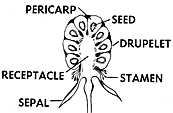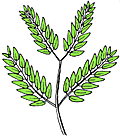Chinaberry
Melia azedarach
Chinaberry family (Meliaceae)
Post-Cook introduction
Chinaberry, or pride-of-India, is a popular ornamental tree planted for its showy cluster of pale purplish fiveparted spreading flowers and for the shade of its dense dark green foliage. It is further characterized by the leaves with long-pointed saw- and pungent odor when crushed, and by the clusters of nearly round golden yellow poisonous berries conspicuous when leafless.

©2006 John R. Gwaltney, Southeastern Flora
Leaves 8–16 inches (20–40 ) or more in length, or partly numerous short-stalked, paired along slender green branches of leaf axis but single at ends, lance-shaped to 1–2 inches (2.5–5 ) long and 3⁄8–3⁄4 inch (1–2 ) wide, short-pointed and mostly one-sided at base, thin, hairless or nearly so, dark green on upper surface, and paler beneath.
Flower clusters () 4–10 inches (10-25 ) long at leaf bases, long-stalked and branched. Flowers showy fragrant, numerous on slender stalks, about 3⁄8 inch (10 ) long and 5⁄8–3⁄4 inch (15–19 ) wide. of 5 greenish 1⁄16 inch (1.5 ) long; 5 pale purplish or lilac-colored petals 3⁄8 inch (10 ) long, narrow, spreading and slightly turned back; usually 10 on narrow violet tube of 5⁄16 inch (8 ); and pale green 5⁄16 inch (8 ) long with at base, 3–6 celled and long
or berries () about 5⁄8 inch (15 ) in diameter, smooth, but becoming a little shriveled, slightly fleshy. Stone hard, containing five or fewer narrow dark brown seeds 5⁄16 inch (8 ) long. These are bitter, with poisonous or narcotic properties. Flowering from March to June in Hawaii, the old slightly wrinkled yellow are generally present.
Sapwood yellowish white, heartwood light brown to reddish brown and attractively marked. Wood is moderately soft, weak and brittle, and very susceptible to attack by drywood termites. Uses of the wood elsewhere include tool handles, cabinets, furniture, and cigar boxes. It has not been used in Hawaii.
Extensively planted around the world for ornament and shade. This attractive tree is easily propagated from seeds, cuttings, and sprouts from stumps. It grows rapidly but is short-lived, and the brittle limbs are easily broken by the wind.
This species is poisonous, at least in some pans, and has insecticidal properties. Leaves and dried have been used to protect stored clothing and other articles against insects. Various pans of the tree, including flowers, leaves, bark, and roots, have been employed medicinally in different countries. The berries are toxic to animals and have killed pigs, though cattle and birds reportedly eat the An oil suitable for illumination was extracted experimentally from the berries. The hard, angular, bony centers of the when removed by boiling, are dyed and strung as beads. In parts of Asia this is a sacred tree.
Commonly cultivated and naturalized through the Hawaiian Islands in lowlands. It is reported to be hardy up to 9000 ft (2743 ) altitude, especially in uplands of Kauai, Maul, and Hawaii. Birds apparently have spread the Introduced into Hawaii about 1839, according to Degener. It may be seen commonly along the roads of the Kona District of Hawaii and near Ulupalakua Ranch on Maui.
Special areas
Waimea Arboretum, Tantalus
Champion
Height 75 ft (22.9 ), c.b.h. 18.5 ft (5.6 ), spread 96 ft (29.3 ). Koahe, South Kona, Hawaii (1967).
Range
Native of southern Asia, probably from Iran and Himalaya to China, but cultivated and naturalized in tropical and warm temperate regions of the world. Widely planted and escaped and naturalized locally in southeastern continental United States, California, Puerto Rico, and Virgin Islands.
Other common names
’inia, ‘ilinia (Hawaii); chinatree, umbrella-tree, umbrella chinaberry, Indian-lilac, Persian lilac, beadtree; alelaila, lilaila, pasilla (Puerto Rico); lilac (Virgin Islands); paraiso (Spanish); lelah (Pohnpei).
Umbrella chinaberry, or Texas umbrella-tree, is a horticultural variety with a compact of erect radiating branches and drooping foliage. The Hawaiian name ‘inia is a corruption of the word India, according to Degener.










